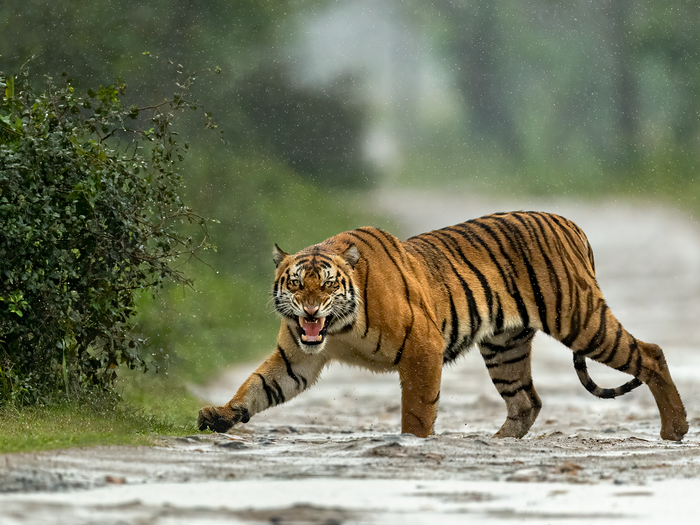
Mohan Thomas

Taken in Kaziranga National Park in Assam, where the tigers are particularly shy and refuse to come on the road, Thomas captured this moment of evident irritability when the park was relatively empty due to torrential rains. The tiger was in the main shrubland, but Thomas had a gut feeling the cat would show itself on the road. The driver of the jeep disagreed with him but eventually agreed to move the jeep back and park it sideways so that Mohan could get a low shot. And lo and behold, just as the driver was backing up and parking, this male showed himself and was clearly displeased with the audience.

Scarface, as he is popularly known, this leopard is somewhat of a legend in Nagarhole National Park in Karnataka. Once known as the leopard capital of India, the sightings at Nagarahole have reduced because of the increase in the tiger population. This picture was captured in an early misty morning safari. While lots of enthusiasts heard the call and thought they would see the leopard, most gave up and left, but not Thomas. And the ‘patience, perseverance and persistence’ mantra worked and he could catch this moment in his camera.

Elephants hold a soft spot in Thomas’ heart, and why not — look at this image that captures a young female blissfully eating her breakfast as the sun rises in Corbett National Park in the state of Uttarakhand. Once sporting a robust population, the numbers of these magnificent creatures is steadily declining. Once sporting a robust population, the numbers of these magnificent creatures is steadily declining — there are approximately 27,000 left in the wild.

This gorgeous black panther was sighted in Nagarhole National Park in Karnataka. Should you be yearning to catch a glimpse of this creature, Nagarhole would be your safest bet. Thomas has seen a black panther 16 times — 14 times in Nagarhole including once mating — once in Dandeli Anshi Tiger Reserve (now Kali Tiger Reserve) and once in Mudumalai Tiger Reserve.

Shot in the Ngorongoro Conservation Area in Tanzania, this beautiful beast was pictured in full stretch after a long nap. The lions, here, are particularly known for their thick mane. Deemed a World Heritage Site, Ngorongoro in the Arusha region of northern Tanzania covers an area of 8,300 square kilometres and hosts a smorgasbord of wild creatures including leopards, cheetahs, the endangered black rhinoceros, the wildebeest, zebras and more than 400 species of bird, among many others.

The picture of this male leopard was taken in the Serengeti National Park, Tanzania. The leopard managed to prop his meal, a young buffalo, up this tree and took a break from his meal to pose for the camera. Rife with an abundance of wildlife, this UNESCO World Heritage Centre spans 14,763 square kilometres and has some rather renowned residents including, but certainly not limited to, lions, leopards, rhinos, zebras and cheetahs.

This brown bear is among the many who feast on salmons that embark on the arduous journey from the sea to the freshwaters to lay their eggs. Taken in Kamchatka Peninsula in Russia, this is one of the few spots where people can witness the spectacular event known as the salmon run, which is essentially the time when thousands of salmon swim upstream to spawn where they themselves hatched. The Kurile Lake here is teeming with salmon, and therefore bears, for a limited time. The area is open to visitors only six weeks in a year and they are allowed to book for only three days at most.

Thomas has been to the Svalbard Islands, a Norwegian archipelago in the Arctic Ocean, a couple of times. This picture of this polar bear was captured during a 10-day trip by ship to the areas where these fabulous creatures reside along with walruses, seals, reindeers, among others. Sadly, global warming has taken a toll on their numbers. Thomas has seen two dead polar bears, who probably died of starvation.
 Saudi Arabia wants China to help fund its struggling $500 billion Neom megaproject. Investors may not be too excited.
Saudi Arabia wants China to help fund its struggling $500 billion Neom megaproject. Investors may not be too excited. I spent $2,000 for 7 nights in a 179-square-foot room on one of the world's largest cruise ships. Take a look inside my cabin.
I spent $2,000 for 7 nights in a 179-square-foot room on one of the world's largest cruise ships. Take a look inside my cabin. One of the world's only 5-star airlines seems to be considering asking business-class passengers to bring their own cutlery
One of the world's only 5-star airlines seems to be considering asking business-class passengers to bring their own cutlery Experts warn of rising temperatures in Bengaluru as Phase 2 of Lok Sabha elections draws near
Experts warn of rising temperatures in Bengaluru as Phase 2 of Lok Sabha elections draws near
 Axis Bank posts net profit of ₹7,129 cr in March quarter
Axis Bank posts net profit of ₹7,129 cr in March quarter
 7 Best tourist places to visit in Rishikesh in 2024
7 Best tourist places to visit in Rishikesh in 2024

Copyright © 2024. Times Internet Limited. All rights reserved.For reprint rights. Times Syndication Service.